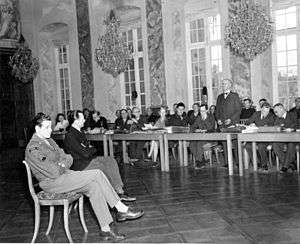Borkum Island war crimes trial
The Borkum Island war crimes trial involved the prosecution of ten German soldiers and five German civilians[1] accused and found guilty of war crimes committed on the island of Borkum against seven American airmen during World War II. The airmen had been deliberately exposed to harassment and subsequently executed.
Background
| Borkum Island Massacre | |
|---|---|
| Location | Borkum Island |
| Date | August 4, 1944 |
Attack type | Massacre |
| Deaths | 7 |
| Perpetrators |
|
The Borkum Island war trial followed the aftermath of the execution of seven United States Army Air Forces by Wehrmacht soldiers stationed on the island of Borkum.[2] On August 4, 1944, Boeing B-17G-75-BO 43-37909 of the 486th BG, crashed into Borkum Island, the site of a German military base.
The airmen aboard included three second lieutenants and four sergeants (Pilot: 2Lt Harvey M Walthall, Co-Pilot: 2Lt William J Myers, Bombardier: 2Lt Howard S Graham, Radio Operator: T/Sgt Kenneth Faber, Ball Turret Gunner: S/Sgt James W Danno, Waist Gunner S/Sgt William F Dold, Tail Gunner: S/Sgt William W Lambertur). All seven airmen survived the crash and surrendered to the German soldiers present on the island.[2]:184
In accordance with typical procedures, the American prisoners should have been handed off to a nearby German naval base and relocated to a prisoner gathering point in the heart of Nazi Germany. However, upon being handed over to the commanding officers on Borkum, the prisoners were marched through the streets of the island and left vulnerable to attack by civilians. The citizens of Borkum were incited by Nazi soldiers to assault the airmen. In addition to inciting the crowd, many of these soldiers were found guilty of participating in the assault. Following the march, the American airmen were shot and executed at the hands of the German soldiers.[3]:188 Scholars point to the "decree" of Joseph Goebbels' propaganda as one potential inspiration for the massacre.[2]:184
Shortly after the incident the island came under British occupation. From this occupation, an intelligence report was filed and followed up on through an investigation by a United States Army Intelligence Corps unit.[2]:190
Trial

Overview
Following the British occupation of Borkum, a more substantive investigation was conducted by a United States Army Intelligence Corps team.[2]:190 With this background, the Borkum Island war trial itself took place in Ludwigsburg, Germany between February 6 and March 22, 1946[2]:183 in the case of U.S. v Kurt Goebell et al. The court found all accused guilty of "common criminal design" and some members guilty of unlawful murder.[3]
The trial was conducted by a combination of American and German defense counsels. Each American counsel was assigned defense of three groups of officers, soldiers, and civilians. The German counsel members were assigned one defendant each.[2]:190
Accusations

Charges were brought against 23 German persons and others who could not be located for the crimes against the seven United States airmen. While 23 individuals were accused of wrongdoing, only 15 could be identified by name and tried in court.[2]:191 Of the crowd that abused the soldiers, not all could be identified, named, and brought before the court.
The charges stated that the accused had "willfully, deliberately, and wrongfully, encouraged, aided, abetted, and participated in a violation of the laws of war by the killing of and by assault upon the named seven person who were then surrendered prisoners of war in the custody of the then German Reich".[2]:191
Trial
The prosecution demonstrated that the American soldiers' march had been deliberately planned by the Wehrmacht soldiers on Borkum. With the route's plan in mind, the prosecution argued that the route had exposed the soldiers to a maximum potential for violence from civilians. Additionally, eyewitness testimony was brought forth. Civilians at the march stated, guards "constantly beat and kicked the fliers throughout the march."[1]
In terms of logistics, the trial was conducted in English and then translated into German, and back again. Additionally, the trial was open to those in the public and press, which both American and German journalists attended.[2]:191
Much like other war crimes of the era, the verdicts were handed down in verdicts of either guilty or not guilty. In all cases, except for Meyer-Gerhards, the accused received punishment. In many of the cases, the sentences were reduced from their previous issue.[2]:193

Sentences
| Name | Sentence |
|---|---|
| Akkermann, Jan J. | Death Sentence |
| Albrecht, Guenther | 6 Years |
| Geyer, Karl | 4 Years |
| Goebell, Kurt | Death Sentence |
| Heinemann, Heinrich | Acquittal + 18 Years (R&R: 13 Years) |
| Krolikovski, Walter | Life Sentence (R&R: 14 Years) |
| Mammenga, Gustav | Acquittal + 24 Years |
| Meyer-Gerhards, | Acquittal |
| Pointner, Johann | Acquittal + 5 Years |
| Rommel, Heinrich | Acquittal + 2 Years |
| Schmitz, Johann Josef | Death Sentence |
| Seiler, Jakob | Death Sentence (R&R: Life Sentence) |
| Weber, Karl | Acquittal + 25 Years |
| Wenzel, Erich | Death Sentence |
| Witzke, Heinz | Acquittal + 11 Years |
See also
- Law of war
- Military justice
- War crime
- List of war crimes
- War crimes of the Wehrmacht
- Nuremberg trials
- Dachau trials
- Prisoners of war
- Nazi Germany
- Allied forces (World War II)
- Edward F. Lyons, Jr.
External links
References
- 1 2 Long, Bill (February 27, 1946). "'Death March' Nazis on Trial". The Stars and Stripes. p. 2.
- 1 2 3 4 5 6 7 8 9 10 11 Koessler, Maximilian (1956). "Borkum Island Tragedy and Trial". Journal of Criminal Law and Criminology. 47 (2). Retrieved 23 September 2014.
- 1 2 Sliedregt, Elies (2012). Individual Criminal Responsibility in International Law. Oxford Press. p. 135. ISBN 978-0-19-956036-3. Retrieved 23 September 2014.
- ↑ "Nazi Crimes on Trial". Retrieved 19 September 2014.